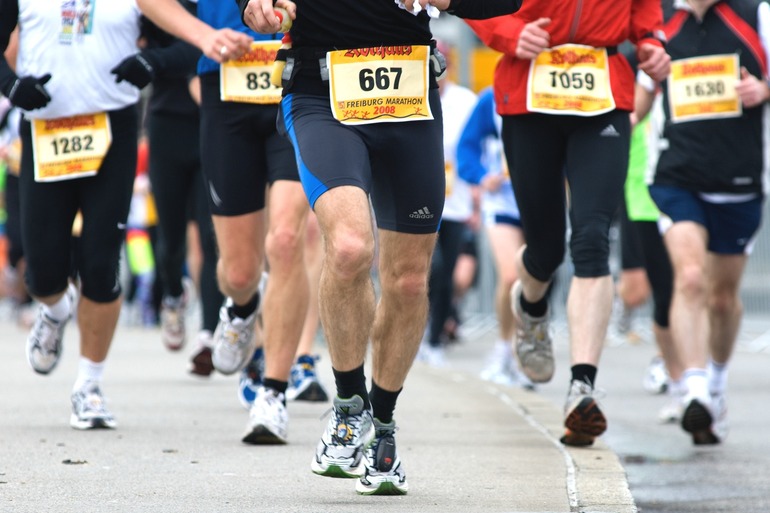The Centers for Advanced Orthopaedics is redefining the way musculoskeletal care is delivered across the region with locations throughout Maryland, DC, Virginia and Pennsylvania.
How to Prevent Common Running Injuries

From the Potomac River Run to the Marine Corps Marathon, the fall weather inspires runners of all levels to enjoy the outdoors and push themselves with a race. Yet some research studies estimate that every year, up to 90 percent of runners will find themselves sidelined with an injury. We asked Daniel Cuttica, D.O., to share tips on how runners can avoid injuries in the weeks leading up to a big race. Dr. Cuttica is an orthopaedic foot and ankle doctor practicing at The Orthopaedic Foot & Ankle care center in Falls Church, Va.
1) What are some of the most common running-related foot and ankle injuries you see?
The most common injuries are overuse injuries, which occur mainly from training errors. When runners ramp up their mileage or speed too quickly, it can be too fast for the body to recover from. These injuries can range from plantar fasciitis and tendonitis to stress fractures of the foot or ankle.
2) What can runners do to prevent these injuries?
The most important thing is to gradually increase your mileage and training before the race. It is recommended to increase the distance you run by just 10 percent each week. You also need to allow time for rest in between runs so your body recovers. Equipment is always important, which means proper shoe wear. Make sure you have a good pair of running shoes that provide enough support.
Finally, stretching and strengthening exercises are key. I think it’s especially important that runners stretch their calves, Achilles tendons and hamstrings to keep their muscles loose and mobile. Strong muscles and tendons give your joints stability, which will limit the stress you experience across your hip, knee and ankle joints. If you’re strong, the muscles don’t fatigue or get overworked as easily, which can lead to overuse injuries.
3) How can improper running form contribute to injury?
Everyone has their own unique form or running style, to some degree, so there’s no one perfect running form. But it’s certainly important to run with good posture. I tell my patients to “run tall” and make sure they have a straight upper torso without arching their back, and to keep the head directly over the shoulders. That posture will limit stress on the back, knees and feet.
You also want to maintain a shorter, quicker stride as opposed to a very long stride where the foot lands in front of the knee, which is known as an overstriding. Overstriding can place more stress on the foot and ankle and knees, which can lead to injury. Instead, your knees should be right above your feet when the foot strikes. Likewise, make sure that your arms are swinging forward and backward with your elbows bent about 90 degrees. You don’t want to rotate your arms across your body and cause extra stress on the elbow and shoulder joints and compromise core stability. In general, you should try to run as relaxed as you can. Less tension in the body means you are less likely to get injured.
4) What role do shoes play in proper running form and preventing injury?
A good pair of running shoes is very important, as they will protect your feet and provide some degree of shock absorption. When purchasing your running shoes, you should take into account your foot type as well. People with higher arches tend to have a stiffer foot, so you should get a neutral shoe with more cushion. If you have a flat foot or are an overpronator – where the foot turns inward and the arch of the foot flattens – then you need a stiffer stability shoe. Once you have the proper pair of shoes, you need to make sure you change them regularly, which is every 300 to 400 miles. Once they wear out, they don’t provide enough support and shock absorption, which can lead to injuries.
5) What should a runner do if they start to feel pain leading up to a big race?
If you start to feel pain as you are running, you have to listen to your body and back off. That’s a sign that there may be an early injury, and if you keep running through it you’re going to turn a minor injury into a much more significant injury with a longer recovery period. Now, you can still keep up with your training regimen by cross-training with the elliptical machine, bike or water running, as well as strength training and stretching. An injury doesn’t mean you have to stop exercising, and these are a few ways that you can maintain your cardio fitness level while still protecting your injury and letting that part of your body heal.
If you experience pain after a run and it lasts more than a few days, or if the pain is severe, then it is necessary to receive proper medical attention from a physician.
Daniel Cuttica, D.O., is a board-certified orthopaedic surgeon specializing in foot and ankle surgery at The Orthopaedic Foot & Ankle care center in Falls Church, VA. Dr. Cuttica has expertise in both common and complex disorders of the foot and ankle, including cartilage disorders and restoration, total ankle replacement, arthroscopy and minimally-invasive procedures and forefoot reconstruction. He serves as an orthopaedic consultant for The Washington Ballet, has authored numerous publications in peer-reviewed journals and is a reviewer for the peer-reviewed journals Foot and Ankle International and Foot and Ankle Specialist.